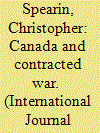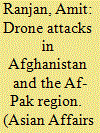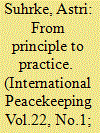|
|
|
Sort Order |
|
|
|
Items / Page
|
|
|
|
|
|
|
| Srl | Item |
| 1 |
ID:
134560


|
|
|
|
|
| Summary/Abstract |
It is essential that Russia avoid unilateral involvement in Afghan affairs, which otherwise would have adverse consequences for Russia’s national interests both regionally and internationally. And this is the scenario the U.S. is likely to try to push forward given current tense U.S.-Russia relations.
|
|
|
|
|
|
|
|
|
|
|
|
|
|
|
|
| 2 |
ID:
136447


|
|
|
|
|
| Summary/Abstract |
In the mid-1990s, unprecedented interventions by private companies specializing in the delivery of military muscle and know-how began altering the dynamics of local conflicts. Since then, private military and security companies have transformed the dynamics of local security delivery around the world, most prominently in Iraq and Afghanistan. In the process, the private military industry has generated plenty of profit and attention, both alarmist and analytical. Two totems of research into the burgeoning industry and its implications are Corporate Warriors by P.W. Singer and The Market for Force by Deborah Avant. Nearly a decade after their publication, these books remain among the most in-depth and sustained treatments of the industry. This essay looks back at the arguments presented in each book and their influence on subsequent research on military privatization.
|
|
|
|
|
|
|
|
|
|
|
|
|
|
|
|
| 3 |
ID:
135648


|
|
|
|
|
| Summary/Abstract |
First it was Syria, now Iraq and the creation of a Caliphate incorporating parts of Syria and Iraq by ISIS (now simply IS) that will take the West’s eye further off Afghanistan a second time. Earlier, American President Barack Obama’s stunning political statement fixing the deadline for final troop withdrawal from Afghanistan as end-2016, not as widely believed, 2025, contingent upon the signing of the Bilateral Security Agreement was psychologically a negative development. Obama has outlined a new strategy for a new coalition of the willing that will attempt to roll back IS over the next three years. Precious resources will be diverted to fight the new war against the most extreme and violent form of terrorism that has attracted nearly 15,000 foreign Muslim youth.
|
|
|
|
|
|
|
|
|
|
|
|
|
|
|
|
| 4 |
ID:
136445


|
|
|
|
|
| Summary/Abstract |
It is important to recognize the multifaceted, and sometimes necessary, role military and security contracting played in supporting the Canadian Armed Forces (CAF) in Afghanistan. It is also important to assess the degree to which this expeditionary experience might shape later Canadian engagement with the private sector. To do so, the paper first identifies the four key areas of CAF military and security contracting pertaining to the mission in Afghanistan: logistics and support personnel, equipment, training, and defensive security. Regarding this last form of contracting, the paper then focuses on Canadian engagement in the development of the Montreux Document and the subsequent creation of the draft National Defence Directive on the Selection and Use of Private Military and Security Contractors on Deployed Operations. Unlike other endeavours, this activism explicitly recognized Canadian reliance on contractors and the need to manage the risk associated with contracting. The paper’s final section suggests the manner in which the directive will shape future contracting decisions, especially given the growing connections between contracting for logistics, training, and defensive security.
|
|
|
|
|
|
|
|
|
|
|
|
|
|
|
|
| 5 |
ID:
137400


|
|
|
|
|
| Summary/Abstract |
A basic trade-off in military cooperation exists: States must respond to the dominant ally’s demands and act as a reliable partner while simultaneously making a decision that is acceptable to domestic audiences. We argue that compensatory burden-sharing strategies are imperfect but dependable solutions to manage foreign policy decisions at the domestic and alliance levels. Our theoretical expectations are tested using the US-Japan and US-Republic of Korea alliances and, in particular, the contribution of each country to the war in Afghanistan. We find that foreign aid commitments to third parties are made as a form of compensation when alliance expectations are substantial, but the secondary ally's ability to contribute militarily is highly constrained. Foreign aid has therefore served as an alliance management tool.
|
|
|
|
|
|
|
|
|
|
|
|
|
|
|
|
| 6 |
ID:
135091


|
|
|
|
|
| Summary/Abstract |
The author uses the latest theoretical and conceptual approaches to world politics and international security to analyze the Afghan problem. He suggests that certain commonly accepted ideas about the strategic situation in Afghanistan should be reviewed to arrive at more exact interpretations of the “traditional” and “non-traditional” threats and other concepts. He also formulates a concept of systemic securitization for Afghanistan’s future.
|
|
|
|
|
|
|
|
|
|
|
|
|
|
|
|
| 7 |
ID:
135179


|
|
|
|
|
| Summary/Abstract |
The US strategy in Afghanistan has fallen short of neutralizing the insurgency that threatens the future stability. The primary insurgency's leadership council, the Quetta Shura, has effectively managed influence through a shadow government and superior tactics in recruiting marginalized tribal leaders, leading to a questionable outcome once Coalition forces withdraw in 2014. This article summarizes the threat posed by the Quetta Shura, coinciding with the deficiencies in the current US policy, and recommends a more viable strategy conducive to the current circumstances, based on historical and cultural precedence. Coalition forces have put a great amount of time, money, and effort into establishing a more stable Afghanistan. The USA needs a more aggressive strategy to counter the aspirations of the insurgency, thereby giving the Afghans the opportunity to further progress in the future. Under the current circumstances and policies, a peaceful transition after the Coalition withdrawal is becoming more unlikely.
|
|
|
|
|
|
|
|
|
|
|
|
|
|
|
|
| 8 |
ID:
136649


|
|
|
|
|
| Summary/Abstract |
This article addresses the question of why regional cooperation among Afghanistan’s neighbours has been so difficult despite these countries’ common concerns. To answer this question, Afghanistan is conceptualised as placed at the core of overlapping regions: South Asia, the Middle East, Central Asia and, through China’s influence, East Asia. Over the past decade, interactions among different regions ‘through’ Afghanistan have increased, and overlap has intensified. Each of these regions is characterised by more or less intense balance-of-power security dynamics, which have played out in Afghanistan. The fact that the regions that overlap in Afghanistan are predominantly characterised by patterns of conflict helps to explain the difficulties of regional cooperation
|
|
|
|
|
|
|
|
|
|
|
|
|
|
|
|
| 9 |
ID:
135347


|
|
|
|
|
| Summary/Abstract |
This paper is an attempt to analyse the contentious role of drone strikes in the context of the options available in the on-going fight against terrorism in Afghanistan and the Af-Pak region. There are significant legal issues here, both in terms of human rights and in terms of state sovereignty and independence, though there are those who argue that the concept of a “just war” provides adequate justification. Pragmatists focus on effectiveness. In Afghanistan and Pakistan, there are many individuals who lend their support to the drone attacks because they see no other alternative(s), given that the prospects for dialogue seems so unpromising. But however many jihadist leaders are killed, in drone strikes, other effective counter-insurgency action may provide a better option.
|
|
|
|
|
|
|
|
|
|
|
|
|
|
|
|
| 10 |
ID:
135686


|
|
|
|
|
| Summary/Abstract |
The Islamic movement of Uzbekistan has focused primarily on Afghanistan over Central Asia, hoping that Taliban fighters will returns north to help fight its caused. Antonio Ciustozzi examines the group’s strategy and relations with Jihadist Network
|
|
|
|
|
|
|
|
|
|
|
|
|
|
|
|
| 11 |
ID:
135340


|
|
|
|
|
| Summary/Abstract |
The United States and its allies entered Afghanistan with nearly unlimited war aims, but with the intention of only using limited force. This strategic error undermined the intervention and made success difficult or impossible. Through an examination of Clausewitzian thought about popular war, limited war and the culminating point of victory, this article shows the enduring value of Clausewitzian concepts in contemporary conflicts against non-state actors. These concepts are tested in three cases – the involvement of the United States, the United Kingdom, and France in Afghanistan – to examine the relationship between their war aims, resource commitments, and war outcome. Of the three, France deployed relatively the most forces to Afghanistan, but the allied engagement remained insufficient to overcome the insurgency. Lacking sufficient mass, the limited forces were insufficient to establish the strategic superiority necessary to achieve nearly unlimited goals. This was compounded by a failure to concentrate against the insurgents crossing the border from Pakistan. In the absence of a clear political determination to reconcile means and ends, the culminating point of victory passed in 2006. It is not the intention here to recommend that contemporary military deployments follow Clausewitzian ideas to the letter; that is not what Clausewitz intended. It is clear, however, that NATO allies in Afghanistan failed to be stronger than the enemy where it was necessary, even when the insurgent groups were diffuse and only loosely unified.
|
|
|
|
|
|
|
|
|
|
|
|
|
|
|
|
| 12 |
ID:
137142


|
|
|
|
|
| Summary/Abstract |
During its engagement in Afghanistan, the US military seriously tried to mitigate the risk of civilian casualties from airstrikes only when called for by changes in military doctrine emphasizing the need to gain the support of the population. Consistent efforts by external political and humanitarian actors to reduce casualties by demanding more transparency and clearer lines of accountability for ‘collateral damage’ had little immediate, observable effect. The case study underlines the contingent nature of progress towards protecting civilians in armed conflict even when a military institution formally accepts the principles of customary international humanitarian law, but concludes that, faute de mieux, strategies to enhance protection through greater accountability and attention to the kind of military ordinance used remain central.
Over time there have been significant advances in international humanitarian law to strengthen the protection of civilians during armed conflict, and, as Adam Roberts notes, ‘in practice something has been achieved’.1 The record of the US military forces in Afghanistan after 2001, however, underlines the element of contingency in this development. During more than a decade of combat engagement in Afghanistan, the US military operated in a context of customary international law that was formally observed, but measures to reduce the impact of military operations on civilians varied significantly in practice. Only in two short periods did the USA or joint ISAF (International Security Assistance Force) command adopt practices to seriously mitigate the risk of civilian casualties. What explains this variation over time, and what does it tell us about the influence of legal norms on the belligerent?
Civilian casualties produced by US airstrikes produced the vast majority of casualties attributed to allied operations in Afghanistan. Authoritative sources reported almost 2,000 were killed and many more injured in the period 2006–13 (see Table 1).2 The US military and ISAF considered the civilian deaths as incidental damage – the unfortunate, accidental effects of war. Yet as Neta Crawford has argued, these effects were systemic in nature.3 They were ‘normal accidents’ in the sense originally developed by Charles Perrow: the predictable outcome of a flawed system design.4
|
|
|
|
|
|
|
|
|
|
|
|
|
|
|
|
| 13 |
ID:
135342


|
|
|
|
|
| Summary/Abstract |
We need to remember that we went into Afghanistan to eject Al Qaeda, not to improve women's rights. But the very success of our mission left us with responsibilities. Much has been achieved in health, in education, in creating a tax base and in governance-the recent elections were a conspicuous success, largely ignored by the media. But many problems remain, not least corruption. And there is the ongoing struggle with the Taliban Now, after more than ten years of engagement, NATO combat troops will withdraw at the end of 2014. This does not mean the Afghans will be abandoned. There will still be high levels of support for training and logistics. But what will happen? On the evidence so far, the Afghan Forces are likely to be able to prevent the Taliban taking over as long as the international community continues to pay the multi-billion dollar bill to sustain them. There are some grounds for thinking that a negotiated settlement with the Taliban is not impossible, partly because over the last decade, much has changed in Afghanistan. But It is still a poor country, not (yet) a liberal western democracy. One prophecy can be made with some certainty: if we do not continue to provide support, especially financial support, the result will be a rapid reversion to instability and conflict.
|
|
|
|
|
|
|
|
|
|
|
|
|
|
|
|
| 14 |
ID:
135190


|
|
|
|
|
| Summary/Abstract |
After 13 years of war, the loss of many thousands of lives, and the expenditure of trillions of dollars, what has the United States learned? The answer depends on not only who is asking but when. The story of the Iraq war would have different endings, and morals, if told in 2003, 2006, 2011, or 2014, and it will continue to evolve. As for Afghanistan, the narrative there has also shifted over time, and the ending also remains in doubt. Neither disaster has been unmitigated. But few would argue that Washington’s approach to either has been a success worth emulating. So the most important question today is what can be learned from the failures.
|
|
|
|
|
|
|
|
|
|
|
|
|
|
|
|
| 15 |
ID:
135857


|
|
|
|
|
| Summary/Abstract |
After having participated in the civil war and later ruled Afghanistan in the 1990s, the current Taliban have a third life as insurgents against the Afghan government and its foreign supporters. Their aim is to return to power and establish an Islamic system. Pakistani shelter and support, guerrilla warfare, and terrorist tactics allowed the Neo-Taliban to extend their influence, particularly to the south and east of Afghanistan. They used the weakness of the Hamid Karzai regime to set up shadow governments. Since even the coalition forces have abandoned the aim of defeating them, the Taliban are guaranteed survival after foreign combat troops leave Afghanistan at the end of 2014. Due to the different interests of the main stakeholders—the Afghan government, the Taliban, the United States, and Pakistan—it is unlikely that the conflict will end by negotiations any time soon. Thus, the civil war will continue. When the Taliban try to extend their reach beyond rural areas and into non-Pashtun districts, they will meet tough resistance. Therefore, it is likely that the fragmentation of Afghanistan will persist and that the Taliban will not return as rulers of a united Afghanistan.
|
|
|
|
|
|
|
|
|
|
|
|
|
|
|
|
| 16 |
ID:
135371


|
|
|
|
|
| Summary/Abstract |
In May 2009, Lieutenant Mark Evison, of the 1st Battalion Welsh Guards, was shot in the shoulder during an ambush on his platoon while on patrol in the Nad-e Ali district of Helmand Province, Afghanistan. Three days later, having first been flown to Camp Bastion for emergency surgery and then to the UK for further treatment, he was declared brain dead and his family switched off his life-support machines. In this article, Lieutenant Evison's mother provides a very personal reflection on the extremely difficult period following his death, recalling her impressions of the support provided to the platoon members, and the legal process that followed in the form of the coroner's inquest.
|
|
|
|
|
|
|
|
|
|
|
|
|
|
|
|
| 17 |
ID:
135859


|
|
|
|
|
| Summary/Abstract |
In Afghanistan ethnic Hazaras are a group with a long history of marginalization, and even outright persecution, mainly because of their Shi'a Muslim faith. Only after the international intervention in 2001 have socio-economic opportunities started to open up for Hazaras. Hazaras, however, maintain a strong perception of still being considered second-class citizens, claiming to be overlooked by the Afghan government and allotted fewer funds by the international development community. This paper examines Hazara perceptions of marginality with reference to one issue: the lack of state-provided electricity in Bamyan province, which many consider the Hazara homeland. Anti-government protests in Bamyan often revolve around this particular issue, and the demand for electricity has become part of the permanent landscape, through a lantern sculpture in Bamyan's main square, as well as through the experience of living one's everyday life with a lack of easily available electric light. The lack of electricity becomes an embodied, daily reminder of perceived subordination to other religio-ethnic groups and the feeling of being left behind by the international community.
|
|
|
|
|
|
|
|
|
|
|
|
|
|
|
|
| 18 |
ID:
135372


|
|
|
|
|
| Summary/Abstract |
Private security companies have recently been the subject of increased attention not only because of their large-scale involvement in US operations in Iraq and Afghanistan, but also due to the employment of privately contracted armed guards to protect ships, crews and cargoes at sea – particularly in the Gulf of Aden. Most of these operations, however, have taken place in a legal grey area, with few agreed standards to regulate the work of private security providers. Dirk Siebels explores the ongoing efforts by governments, international organisations and the industry to address this legal vacuum and establish effective guidelines.
|
|
|
|
|
|
|
|
|
|
|
|
|
|
|
|
| 19 |
ID:
134731


|
|
|
|
|
| Summary/Abstract |
The terrorist attacks on the World Trade Center and Pentagon on 9/11 2001 had a grave impact on the way the conflict dynamics in world politics have been shaped, structured and interpreted since then. The invasions of Afghanistan (2001) and Iraq (2003), the US drone programs launched during the first decade of the 00’s in countries like Pakistan, Yemen and Somalia and the more recent interventions in Libya (2011), and Mali (2013) have all at some point been related to the concern of combatting international terrorism. To fight or prevent international terrorism still appears as a top-priority for the great powers of the West and questions about the role of religion in explaining the motivations and occurrences of terrorist acts still remain topical.
|
|
|
|
|
|
|
|
|
|
|
|
|
|
|
|
| 20 |
ID:
136425


|
|
|
|
|
| Summary/Abstract |
The authors analyze Islam as one of the most important, if not decisive, factors responsible for the country’s future; they reveal the specifics of its functioning in Afghan society as the state religion, investigate in great detail the contradictions between individual groups and organizations involved in the conflict of the last quarter of the twentieth century, and examine their impact on the social and economic relations in the region. The sides in the conflict belong to different ethnic, confessional, and political groups. The continued disagreements between the official Muslim clergy and government in Afghanistan are a truthful reflection of the degree to which Islam affects the state’s life-supporting spheres and figure prominently in ethnic strife and tribal enmity, along with all kinds of external factors that keep the conflict alive.
The article looks at the main Islamist organizations that will figure prominently on Afghanistan’s domestic scene for several decades to come.
The authors believe that in the current conditions, Islam has ceased to be a factor of social stability and unity in Afghanistan.
|
|
|
|
|
|
|
|
|
|
|
|
|
|
|
|
|
|
|
|
|